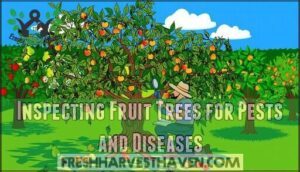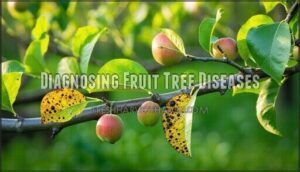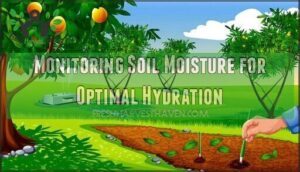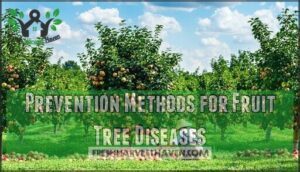This site is supported by our readers. We may earn a commission, at no cost to you, if you purchase through links.

Brown patches on foliage often signal leaf blight, while soft spots on fruit indicate decay.
Check for sunken bark areas that suggest cankers, and look for olive-colored spots that scream scab disease.
Don’t forget the roots—waterlogged soil creates perfect conditions for rot.
White powdery coatings mean mildew’s moved in, while oozing wounds point to bark diseases.
The trick is distinguishing between fungal infections, pest damage, and environmental stress since symptoms overlap.
Understanding when spores spread and how disease cycles work makes all the difference in timing your response correctly.
Table Of Contents
- Key Takeaways
- Common Fruit Tree Diseases
- Identifying Fruit Tree Problems
- Diagnosing Fruit Tree Diseases
- Factors Affecting Fruit Tree Health
- Watering Issues in Fruit Trees
- Pest Control and Fruit Tree Health
- Prevention Methods for Fruit Tree Diseases
- Troubleshooting Fruit Tree Problems
- Managing Fruit Tree Diseases
- Frequently Asked Questions (FAQs)
- What does a diseased fruit tree look like?
- What does baking soda do for fruit trees?
- How do I identify what is wrong with my tree?
- Who can diagnose tree disease?
- How do you know if a fruit tree has a disease?
- How do I know if my fruit trees are bad?
- How do I know if my fruit tree has a virus?
- Can you spot common fruit tree diseases early?
- Do fruit trees have diseases?
- How do you know if a fruit tree has fungus?
- Conclusion
Key Takeaways
- You’ll diagnose problems by playing detective – examine leaves for brown patches and spots, check bark for cankers and oozing wounds, inspect fruit for soft decay, and look for root rot in waterlogged soil to identify whether you’re dealing with fungal infections, pest damage, or environmental stress.
- You can prevent most diseases through smart choices – select disease-resistant varieties for your climate, maintain proper pruning with disinfected tools, ensure good air circulation, and practice orchard sanitation by removing fallen leaves and infected debris immediately.
- You’ll need to distinguish between different problems – disease symptoms appear as spots, discoloration, or wilting that spreads gradually, while pest damage shows as chewed leaves, holes, or sticky residue in localized clusters, helping you choose the right treatment approach.
- You should monitor regularly and act fast – check your trees weekly during the growing season, document findings with photos, and implement early intervention when you spot warning signs, since catching problems before they spread saves time, money, and potentially your entire orchard.
Common Fruit Tree Diseases
Fruit trees face various diseases that can severely impact their health, from fungal infections like black rot and apple scab to bacterial threats such as fire blight.
Recognizing early symptoms helps you take swift action before these problems spread throughout your orchard and destroy your harvest, which is crucial for maintaining the health of your fruit trees.
Symptoms and Causes of Fruit Tree Diseases
When tree disease symptoms crop up, you’ll notice telltale signs like leaf blight creating brown patches, fruit decay causing soft spots, and tree cankers forming sunken bark areas.
Watch your trees closely—they’re always telling their story through every leaf and branch
Fungal infections often trigger root rot in waterlogged soil, while bark diseases manifest as oozing wounds.
Early tree disease identification helps you tackle problems before they spread throughout your orchard, which is crucial for preventing the spread of tree cankers.
Black Rot and Fire Blight Prevention
Between proper prevention measures and vigilant care, you’ll protect your fruit trees from these devastating diseases.
Essential disease prevention starts with these key practices:
- Select resistant varieties that naturally fight black rot and fire blight infections
- Apply copper fungicides before bud break for maximum protection
- Disinfect pruning tools with 70% alcohol between every cut
Effective orchard sanitation and proper pruning techniques eliminate disease entry points.
Regular tool disinfection prevents spreading pathogens from tree to tree, while copper fungicides create a protective barrier during vulnerable growth periods.
Choosing disease-resistant tree varieties is also a key preventative measure.
Identifying Fungal Diseases on Fruit Trees
Beyond black rot and fire blight prevention, you’ll encounter various fungal infections requiring different approaches.
Scab identification starts with olive-colored spots on leaves and fruit, while mildew recognition involves white powdery coatings.
Rot symptoms appear as brown lesions spreading across ripening fruit.
Leaf spots create reddish-brown patches that weaken trees, and knot diagnosis reveals black, swollen growths on branches.
Early disease diagnosis through regular inspection helps you catch fruit tree fungus before it spreads, making fungicide application more effective against these persistent disease symptoms.
Identifying Fruit Tree Problems
Successful fruit tree care starts with knowing what to look for when something’s wrong.
You’ll need to develop a keen eye for spotting the difference between diseases, pest damage, and environmental stress before problems spiral out of control, which is crucial for effective care.
Common Signs of Fruit Tree Stress
Recognizing stress signals early can save your tree from serious damage.
Your fruit tree communicates distress through visible changes that shouldn’t be ignored.
Listen to your trees—they’re speaking volumes through their leaves, bark, and branches.
- Discolored Leaves – Yellow, brown, or spotted foliage indicates disease symptoms or nutrient deficiency
- Stunted Growth – Poor fruiting and reduced vigor signal underlying tree health diagnosis issues
- Bark Changes – Cracking, cankers, or unusual growths reveal sick fruit tree problems
- Branch Dieback – Dead or dying limbs suggest serious tree leaf problems requiring immediate attention
Recognizing Disease Vs. Pest Damage
Spotting the culprit behind your tree’s troubles requires detective work, but disease symptomology differs substantially from pest infestation signs.
Disease symptoms typically show as spots, discoloration, or wilting, while pest damage appears as chewed leaves, holes, or sticky residue.
| Damage Type | Disease Symptoms | Pest Damage |
|---|---|---|
| Leaf Issues | Spots, yellowing, powdery coating | Chewed edges, holes, skeletonized leaves |
| Fruit Problems | Scabs, rot, discoloration | Puncture marks, tunnels, premature drop |
| Branch/Bark | Cankers, galls, blackening | Sawdust trails, entry holes, webbing |
| Residue Signs | Fungal growth, mold patches | Honeydew, frass, insect casings |
| Pattern | Spreads gradually, uniform | Localized clusters, random distribution |
Understanding these visible differences helps you choose the right treatment approach for diagnosing tree problems effectively.
Inspecting Fruit Trees for Pests and Diseases
Visual inspection forms your first line of defense against fruit tree diseases and pest damage. Start by examining leaves, bark, and fruit systematically, looking for unusual spots, discoloration, or physical damage. Early detection saves time and prevents widespread problems from developing.
- Check weekly during growing season – Regular monitoring frequency catches issues before they spread throughout your orchard
- Document findings with photos – Record keeping helps track patterns and aids disease diagnosis when consulting professionals
Look for common disease symptoms like black spots, powdery coatings, or wilted branches. Pest identification becomes easier when you spot entry holes, webbing, or sticky honeydew deposits that indicate insect activity.
Diagnosing Fruit Tree Diseases
When you notice leaf spots, wilted branches, or unusual growths on your fruit trees, understanding the disease’s life cycle helps you time treatments effectively and break the infection pattern.
Professional tree care specialists can accurately identify complex diseases through lab testing and provide targeted treatment plans that save you time, money, and potentially your entire orchard, which is a critical aspect of maintaining healthy trees and preventing the spread of disease, thus emphasizing the importance of professional tree care and lab testing.
Understanding Disease Life Cycles
Understanding disease life cycles transforms you from reactive to proactive in fruit tree care.
Know your enemy’s schedule—timing treatments to disease cycles wins the war before battles begin
Fungal overwintering spores hibernate in bark cracks and fallen debris, waiting for spring’s warm, wet conditions.
When environmental triggers like humidity and moderate temperatures align, spore dispersal begins through wind and rain.
Each infection stage follows predictable patterns—dormancy, dispersal, germination, infection, and reproduction.
Recognizing these cycles helps you time treatments effectively, whether targeting dormant spores or active infections.
A common issue to watch out for is powdery mildew infections, which can be identified by white or gray mycelium.
Consulting With a Tree Care Professional
When you’re stumped by stubborn tree issues, an arborist consultation brings professional expertise right to your backyard.
These experts offer accurate diagnosis, lay out treatment options, and provide a clear cost analysis—no surprises.
You’ll get personalized advice for long-term health, plus practical tips for ongoing tree care services.
Think of it as hiring a detective for your orchard, minus the trench coat!
Factors Affecting Fruit Tree Health
Your fruit trees face a complex web of challenges that can make or break their health and productivity.
Understanding how soil quality, environmental conditions, and your tree’s specific needs work together helps you spot problems before they become disasters.
Soil Type and Quality Impact
Your soil type determines whether your fruit trees thrive or struggle with constant health issues.
Poor soil quality creates a domino effect—bad drainage impact leads to root health problems, while wrong soil pH blocks nutrient availability.
Soil compaction suffocates roots, causing nutrient deficiency that weakens your tree’s natural defenses. A balanced soil composition like loamy soil is often ideal for fruit trees.
Here are five key soil factors to monitor:
- Soil pH levels between 6.0-7.0 for best nutrient uptake
- Drainage quality to prevent waterlogged, oxygen-starved roots
- Organic matter content for improved soil structure and fertility
- Compaction levels that restrict root expansion and water infiltration
- Nutrient balance including nitrogen, phosphorus, and potassium availability
Regular soil testing reveals hidden problems before they damage your trees permanently.
Environmental Conditions and Evaporation
Environmental factors constantly challenge your fruit trees’ health. Temperature extremes and high sunlight exposure accelerate water evaporation, while poor air circulation traps moisture around foliage. Humidity levels fluctuate dramatically, creating perfect breeding grounds for fungal problems.
| Environmental Factor | Impact on Trees | Disease Risk |
|---|---|---|
| High heat + wind | Rapid water loss | Stress-related infections |
| Poor air flow | Moisture buildup | Fungal diseases |
| Extreme temperatures | Root/bark damage | Bacterial infections |
| Variable humidity | Inconsistent growth | Multiple pathogens |
Monitor these environmental conditions closely—they’re often the hidden culprits behind mysterious tree ailments.
Species-Specific Water Requirements
Different fruit trees demand customized watering approaches based on their species-specific water requirements. Apple trees thrive with steady moisture, while citrus varieties need deeper, less frequent irrigation.
Drought tolerance varies dramatically—pomegranates handle dry spells better than cherries, which suffer drought stress quickly.
Your irrigation techniques should match each tree’s rootstock influence and natural habitat. Stone fruits require excellent drainage to prevent root diseases, while regional variations in climate affect timing.
Monitor soil moisture regularly, as poor water quality can damage sensitive trees, ultimately impacting fruit quality and harvest success.
Watering Issues in Fruit Trees
Water problems can make or break your fruit trees, and the signs aren’t always obvious until damage is done.
You’ll need to spot the difference between too much and too little water before your trees start showing serious stress symptoms.
Signs of Overwatering and Underwatering
Water troubles manifest through telltale signs that savvy gardeners can easily spot. Overwatering creates yellowing leaves and mushy root health problems, while underwatering produces crispy leaf color changes and poor fruit quality.
Your trees communicate their needs through visible symptoms.
Watch for these critical indicators:
- Check leaf color – yellow suggests excess water, brown edges indicate drought stress
- Test soil moisture depth using the finger method down two inches
- Monitor growth rate – stunted development signals watering imbalances
- Inspect for drainage issues like standing water or soggy conditions
Proper watering techniques prevent both extremes. When soil moisture stays consistently balanced, your fruit trees thrive with healthy foliage and vigorous fruit quality production.
Recognizing Stress and Adjusting Practices
Your tree’s stress symptomology reveals critical information about underlying problems.
When diagnosing damage through careful observation, you’ll spot telltale signs that demand environmental adjustments for long-term health.
| Stress Sign | Root Cause & Action |
|---|---|
| Yellow leaves dropping | Overwatering – reduce frequency, improve drainage |
| Wilting with moist soil | Root rot – stop watering, assess soil conditions |
| Stunted, poor growth | Nutrient deficiency – apply balanced fertilizer |
| Cracked bark | Temperature stress – provide winter protection |
Preventative care means responding quickly to these fruit tree problems before they escalate into serious damage; for example, selecting disease-resistant varieties can substantially improve fruit yields.
Monitoring Soil Moisture for Optimal Hydration
Proper soil moisture monitoring prevents both waterlogged roots and drought stress. Use soil moisture sensors to track hydration levels at different depths, ensuring your irrigation system calibration matches your tree’s needs.
Check water table depth and soil drainage patterns regularly. Consider evapotranspiration rates and mulch application effects when adjusting watering techniques for ideal soil conditions.
Here’s your monitoring checklist:
- Install sensors 6-18 inches deep where feeder roots thrive
- Test soil moisture weekly during growing season peaks
- Adjust watering frequency based on weather and soil type
- Document patterns to perfect your orchard’s hydration rhythm
Pest Control and Fruit Tree Health
Effective pest control starts with knowing your enemy—identifying the specific insects and critters that threaten your fruit trees’ health and productivity.
Once you’ve spotted the culprits, you can choose from organic methods, integrated pest management strategies, or targeted chemical treatments to protect your harvest without harming beneficial insects.
Common Pests Affecting Fruit Trees
Several troublesome pests can devastate your fruit harvest if left unchecked. Aphid Infestations cause leaf curling and sticky honeydew, while Codling Moth larvae tunnel through apples and pears. Spider Mites create webbing and yellowing leaves, especially during dry spells. Scale Insects appear as waxy bumps, weakening trees by sucking sap.
| Pest | Damage | Control Tips |
|---|---|---|
| Aphids | Leaf curling, sticky sap | Encourage ladybugs, prune heavily |
| Codling Moths | Fruit tunneling | Use pheromone traps regularly |
| Scale Insects | Sap-sucking, leaf yellowing | Scrub bark carefully, apply oil |
Quick identification prevents major orchard pest control headaches later.
Using Organic and Integrated Pest Management
Beyond identifying pests, you’ll want smart control methods. Organic IPM combines multiple tactics—think of it as your fruit tree’s security system rather than panic-mode spraying.
Monitoring practices help you catch problems early, while beneficial insects like ladybugs handle pest patrol naturally. Cultural controls create healthier growing conditions, and organic sprays with neem oil provide backup when needed.
To effectively implement these methods, consider using specialized products and tools.
- Encourage beneficial insects with diverse plantings and reduced pesticide use
- Apply organic pest control methods like neem oil and beneficial predator releases
- Use cultural controls: proper pruning, sanitation, and resistant varieties
- Implement IPM strategies that monitor pest levels before taking action
Chemical Control and Safety Precautions
Precision matters when applying chemical control for fruit tree health.
Always follow fungicide application guidelines and wear protective gear—gloves, goggles, and long sleeves protect you from pesticide risks.
Check dosage precision twice; too little won’t work, too much harms beneficial insects and increases environmental impact.
Store fungicides securely away from children and pets.
Safe handling and safe application practices keep your orchard thriving while protecting your family.
Prevention Methods for Fruit Tree Diseases
You can prevent most fruit tree diseases by choosing the right varieties and maintaining good garden hygiene from the start.
Smart prevention beats expensive treatments every time, and it’s easier than you might think.
Planting Disease-Resistant Cultivars and Varieties
When choosing fruit trees, think like you’re building a fortress—disease-resistant varieties are your strongest walls against orchard troubles.
Plant disease-resistant cultivars for a natural shield against trouble—your orchard’s first line of defense for healthy harvests!
Smart cultivar selection starts with understanding your region’s challenges. Rootstock resistance forms your tree’s foundation, while variety disease resistance tackles above-ground issues.
Research fruit tree varieties bred specifically for your climate’s quirks.
Genetic diversity strengthens your orchard’s resilience—don’t plant identical clones everywhere. Cross-pollination benefits include natural vigor, while regional suitability guarantees your resistant trees thrive rather than just survive.
You’ll spend less time fighting diseases and more time enjoying harvests.
Proper Pruning and Disinfecting Techniques
Effective pruning timing during dormancy reduces tree stress and disease risk.
Always use sanitized tools—dip pruning shears in 70% alcohol between cuts to prevent spreading infections.
Make clean, angled cuts above buds to promote proper wound treatment and prevent water accumulation.
Remove diseased branch removal strategically to improve air circulation throughout the canopy.
To maintain hygiene, consider purchasing alcohol for tool cleaning.
These tree pruning techniques create healthier trees that resist future problems naturally.
Regular Monitoring for Early Detection
After sharpening those pruning skills, let’s talk about regular monitoring—it’s like checking your trees’ pulse.
Visual inspections are your best friend.
Spotting disease symptoms early means less drama later.
Keep a notebook handy for record keeping; even a doodle of a wilting leaf helps.
Fast early intervention stops pests in their tracks.
Think of symptom recognition as your tree’s “sneak peek” at trouble.
Don’t let issues sneak past you—catch them before they become headline news.
The key to successful tree care is early intervention and being proactive about pest identification.
- Weekly visual inspections
- Detailed record keeping
- Early intervention
- Pest identification
- Noticing subtle disease symptoms
Troubleshooting Fruit Tree Problems
When your fruit trees aren’t thriving, you’ll need to play detective to identify whether stress, disease, or pests are the culprits.
The key is knowing what to look for and understanding that each tree species has its own quirks and requirements.
Common Issues With Cherry Trees
Cherry trees face several troubling issues that’ll test your patience.
Black knot creates ugly swellings on branches, while cherry and plum leaf spot causes premature leaf drop.
Brown rot attacks blossoms and fruit, gummosis disease oozes sticky sap, and poor fruiting disappoints harvests.
Fruit cracking splits ripe cherries, sunscald damage burns bark, and pest infestation weakens trees.
Regular pruning cherry trees and proper sanitation prevent most fruit tree problems from spiraling out of control.
Climate and Temperature Requirements
Your fruit trees depend on matching their climate needs perfectly. Chill hours below 45°F trigger proper blooming, while frost damage can destroy buds overnight. Know your hardiness zone and select varieties suited to local microclimates and seasonal changes.
Here’s your climate protection checklist:
- Track chill hours – Most fruit trees need 200-1,000 hours below 45°F
- Monitor frost warnings – Cover trees or use water sprinklers during freezes
- Provide wind protection – Install barriers to reduce cold air flow
- Manage sun exposure – Use shade cloth during extreme heat waves
- Choose zone-appropriate varieties – Match trees to your specific hardiness zone
Soil Conditions and Sunlight Needs
Beyond climate factors, your fruit tree’s foundation matters most. Soil pH between 6.0-7.0 supports root health and prevents nutrient deficiency.
Poor soil drainage suffocates roots, while inadequate sunlight exposure weakens immunity against diseases.
| Factor | Requirement |
|---|---|
| Soil pH | 6.0-7.0 (slightly acidic to neutral) |
| Sunlight Needs | 6+ hours direct daily light |
| Soil Type | Well-draining, loamy preferred |
| Drainage Issues | Avoid waterlogged conditions |
Test your soil quality annually—healthy trees start underground!
Managing Fruit Tree Diseases
Once you’ve identified disease symptoms on your fruit trees, it’s time to take action with proven treatment strategies.
You’ll have several effective options at your disposal, from targeted chemical controls to natural remedies and preventive cultural practices that work together to restore your trees’ health.
Chemical Control and Alternative Methods
When you’ve exhausted cultural methods, chemical control becomes your backup plan. Fungicide resistance develops when you overuse the same products, so rotate between different active ingredients to stay ahead of stubborn pathogens.
Organic options like neem oil and baking soda sprays offer gentler alternatives that won’t harm beneficial insects. These work best as preventive measures rather than rescue treatments. For severe infections, synthetic fungicides pack more punch but require careful timing and precise application.
Safe application means reading labels twice and following rates exactly—more isn’t better, it’s wasteful and potentially harmful.
- Apply treatments during calm weather conditions to prevent drift and guarantee targeted coverage of affected areas
IPM strategies combine chemical treatments with biological controls and cultural practices for maximum effectiveness. Remember that soil health affects how well trees can fight off diseases naturally. Healthy soil equals stronger trees that need fewer chemical interventions.
Biological Pest Control and Natural Remedies
While chemicals fight pests aggressively, biological pest control offers a gentler approach.
Beneficial insects like ladybugs and lacewings naturally hunt aphids and mites. Companion planting with marigolds attracts these helpful predators.
Neem oil disrupts pest feeding without harming pollinators, while Bt application targets caterpillars specifically. Dormant oil smothers overwintering eggs effectively.
To maintain healthy trees, consider that proper tree spacing is also vital in preventing pest infestations.
| Control Method | Target Pests | Application Timing |
|---|---|---|
| Neem Oil | Aphids, scale, mites | Growing season |
| Bt Spray | Caterpillars, bagworms | Active feeding period |
| Dormant Oil | Overwintering eggs | Late winter/early spring |
Cultural and Sanitation Practices
Effective orchard hygiene practices form the backbone of successful fruit tree diseases prevention and tree disease identification.
- Tool Disinfection: Clean pruning shears with 70% alcohol between cuts to prevent spreading pathogens during disease diagnosis sessions.
- Orchard Hygiene: Remove fallen leaves, mummified fruit, and infected debris immediately—fungal spores love overwintering in garden litter.
- Pruning Techniques: Cut diseased branches 12 inches beyond visible damage, ensuring proper air circulation through strategic thinning cuts.
- Variety Selection: Choose disease-resistant cultivars that naturally combat common infections, reducing your reliance on chemical interventions substantially.
Frequently Asked Questions (FAQs)
What does a diseased fruit tree look like?
You’ll spot wilted leaves, blackened bark, and stunted growth. Look for unusual spots, discolored fruit, or branches that appear scorched—these signal trouble brewing in your orchard.
What does baking soda do for fruit trees?
Baking soda acts as a natural fungicide that’ll help control powdery mildew, black spot, and other fungal diseases on your fruit trees.
When mixed with water and sprayed on affected foliage, it will help control these diseases.
How do I identify what is wrong with my tree?
Look for specific symptoms: yellowing leaves, spots, wilting, or unusual growths.
Check bark for cankers, examine fruit for lesions, and note any insect activity or webbing to narrow down potential diseases, focusing on specific symptoms.
Who can diagnose tree disease?
When Sarah’s peach tree developed mysterious dark spots, she called her county extension office for expert help.
You can get professional tree disease diagnosis from certified arborists, plant pathologists, extension agents, or tree care specialists who’ll identify problems accurately, using complete concepts and expert help.
How do you know if a fruit tree has a disease?
You’ll notice yellowing leaves, unusual spots, wilted branches, or strange growths on your tree. Check for discolored bark, premature fruit drop, or that telltale "scorched" appearance that screams trouble ahead.
How do I know if my fruit trees are bad?
Like a detective examining clues, you’ll spot trouble through yellowing leaves, dark spots, wilted branches, unusual growths, or fruit with holes and decay—these warning signs reveal your tree’s health problems.
These warning signs are crucial for identifying issues with your tree.
How do I know if my fruit tree has a virus?
Viral infections cause distorted, mottled, or yellowing leaves with unusual patterns.
You’ll notice stunted growth, reduced fruit production, and leaves that curl or develop mosaic-like discoloration that doesn’t match typical fungal symptoms.
Can you spot common fruit tree diseases early?
You’ll spot diseases by checking leaves for unusual spots, discoloration, or wilting, plus examining bark for cankers or swelling, and watching for premature fruit drop or deformed growth patterns.
Do fruit trees have diseases?
Yes, fruit trees definitely get diseases.
You’ll encounter fungal infections like apple scab, black rot, and powdery mildew, plus bacterial problems such as fire blight that can devastate your orchard if left untreated.
How do you know if a fruit tree has fungus?
An ounce of prevention’s worth a pound of cure.
You’ll spot telltale signs like white powdery coatings on leaves, olive-colored spots, orange patches, or blackened areas on fruit and foliage indicating fungal infections.
Conclusion
Successfully diagnosing fruit tree problems separates thriving orchards from struggling ones, yet many growers feel overwhelmed when symptoms first appear.
Armed with this thorough guide, you’re now equipped to identify diseases, distinguish pest damage from environmental stress, and implement targeted treatments.
Remember that early detection saves both time and trees—regular monitoring beats reactive measures every time.
Whether you’re dealing with fungal infections, nutrient deficiencies, or pest invasions, systematic observation and prompt action will keep your fruit trees healthy and productive for years to come, ensuring a long-term healthy outcome.
- https://pestcheck.ca/service-areas/richmond-pest-control/
- https://www.newlifeonahomestead.com/fruit-tree-diseases/
- https://www.bhg.com/gardening/pests/insects-diseases-weeds/tree-disease-photos/
- https://anchortreeservice.ca/tree-tips/common-fruit-tree-diseases-an-in-depth-guide/
- https://extension.umn.edu/planting-and-growing-guides/how-hire-tree-care-professional















